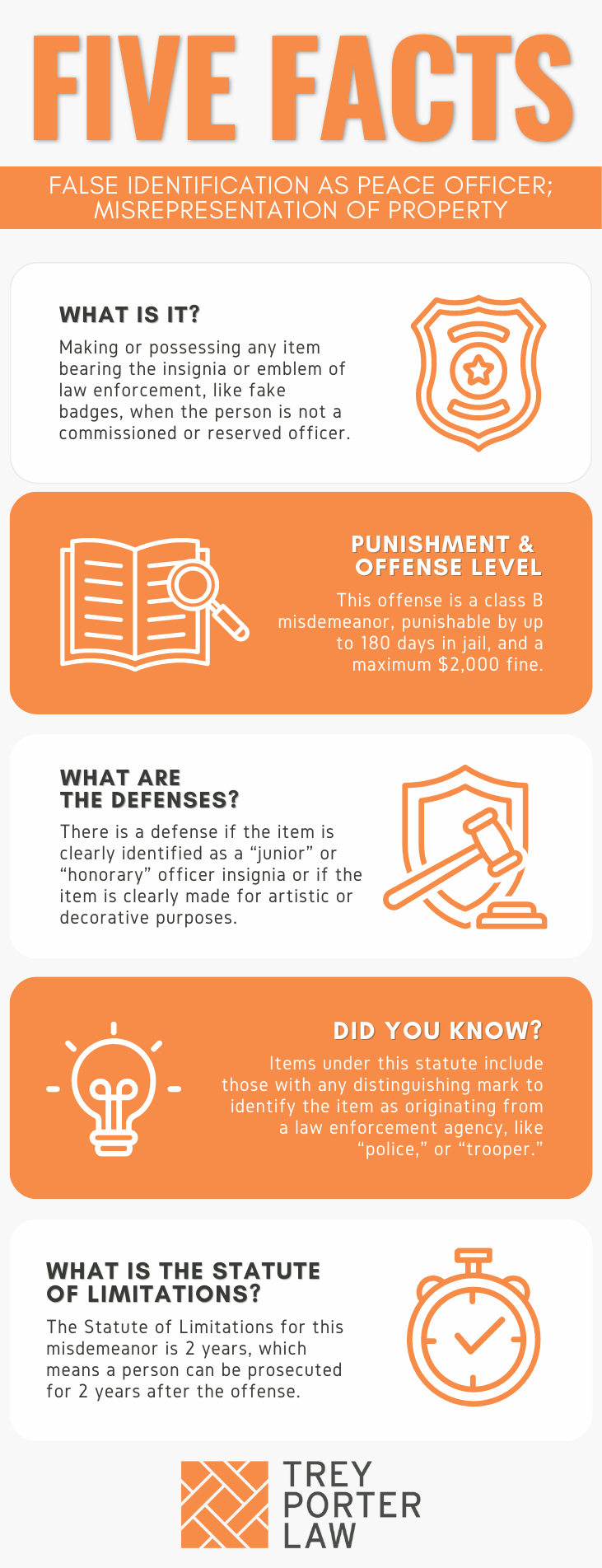WHAT IS FALSE IDENTIFICATION AS PEACE OFFICER; MISREPRESENTATION OF PROPERTY IN TEXAS?
The Texas law against false identification as a peace or misrepresentation of property prohibits making or possessing anything bearing an insignia of a law enforcement agency, when the person is not commissioned as a peace officer or reserve law enforcement officer. Such identifying items include badges, shoulder emblems, cards, documents, or even a vehicle with a law enforcement insignia.

- What is a law enforcement agency insignia? Texas Penal Code Section 37.12 explains an item bearing an insignia of a law enforcement agency includes anything with the word “police,” “sheriff,” “constable,” or “trooper.” It is any distinguishing mark to identify the item as originating from a law enforcement agency.For example, in Gatewood v. State, the defendant was convicted of false identification as a peace officer for wearing a badge with a five-pointed star displaying the words “Texas,” and “Sheriff.” Although it had “Republic of Texas” at the top, which was not a real law enforcement agency, based on the words and appearance, one could rationally conclude it was an official law enforcement agency’s insignia. The appellate court affirmed the conviction.
WHAT IS THE FALSE IDENTIFICATION AS PEACE OFFICER; MISREPRESENTATION OF PROPERTY LAW IN TEXAS?
Tex. Penal Code § 37.12. FALSE IDENTIFICATION AS PEACE OFFICER; MISREPRESENTATION OF PROPERTY.
(a) A person commits an offense if:
(1) the person makes, provides to another person, or possesses a card, document, badge, insignia, shoulder emblem, or other item, including a vehicle, bearing an insignia of a law enforcement agency that identifies a person as a peace officer or a reserve law enforcement officer; and
(2) the person who makes, provides, or possesses the item bearing the insignia knows that the person so identified by the item is not commissioned as a peace officer or reserve law enforcement officer as indicated on the item.
(b) It is a defense to prosecution under this section that:
(1) the card, document, badge, insignia, shoulder emblem, or other item bearing an insignia of a law enforcement agency clearly identifies the person as an honorary or junior peace officer or reserve law enforcement officer, or as a member of a junior posse; or
(2) the person identified as a peace officer or reserve law enforcement officer by the item bearing the insignia was commissioned in that capacity when the item was made.
(b-1) It is an exception to the application of this section that the item was used or intended for use exclusively for decorative purposes or in an artistic or dramatic presentation.
. . .
(d) A person commits an offense if the person intentionally or knowingly misrepresents an object, including a vehicle, as property belonging to a law enforcement agency. For purposes of this subsection, intentionally or knowingly misrepresenting an object as property belonging to a law enforcement agency includes intentionally or knowingly displaying an item bearing an insignia of a law enforcement agency in a manner that would lead a reasonable person to interpret the item as property belonging to a law enforcement agency.
(e) An offense under this section is a Class B misdemeanor.
WHAT IS THE PENALTY CLASS FOR FALSE IDENTIFICATION AS PEACE OFFICER; MISREPRESENTATION OF PROPERTY IN TEXAS?
False identification as a peace officer or misrepresenting property is a Class B misdemeanor, punishable by up to 180 days in county jail.
WHAT IS THE PUNISHMENT RANGE FOR FALSE IDENTIFICATION AS PEACE OFFICER; MISREPRESENTATION OF PROPERTY IN TEXAS?
A person charged with false identification as a peace officer, a Class B misdemeanor, faces up to 180 days in jail, and a maximum fine of $2,000.
WHAT ARE THE PENALTIES FOR FALSE IDENTIFICATION AS PEACE OFFICER; MISREPRESENTATION OF PROPERTY IN TEXAS?
A person charged with false identification as a peace officer may be eligible for probation after a conviction, or deferred adjudication without a conviction, for up to two years.
WHAT ARE THE DEFENSES TO FALSE IDENTIFICATION AS PEACE OFFICER; MISREPRESENTATION OF PROPERTY IN TEXAS?
The law authorizes a defense if the identifying item clearly states the person is an honorary or junior peace officer, or reserve law enforcement officer. The statute also creates an exception for badges, shoulder emblems, and other identifying items if it is clearly part of a costume or “for decorative purposes.”
- Can a former peace officer or reserve law enforcement officer be charged with falsely identifying himself as a peace officer? It depends. The statute creates a defense for false identification as a peace officer if the person in possession of the badge or other item was in fact commissioned at the time the identifying item was made.For example, if a retired peace officer with an expired commission has his old badge in his car, he may raise this statutory defense. However, if the State proves the accused used or intended to use his old badge, uniform, or other item to identify himself as a peace officer, such facts will support a conviction for possessing false identification, and possibly impersonating a public servant.
WHAT IS THE STATUTE OF LIMITATIONS FOR FALSE IDENTIFICATION AS PEACE OFFICER; MISREPRESENTATION OF PROPERTY IN TEXAS?
The limitation period for false identification as a peace officer with a misrepresentation of property, a Class B misdemeanor, is two years.
FALSE IDENTIFICATION AS PEACE OFFICER; MISREPRESENTATION OF PROPERTY IN TEXAS
Making, providing, or otherwise possessing a card, badge document, shoulder emblem, vehicle, or any other item that bears a law enforcement agency insignia is a crime if the person is not a commissioned peace officer as indicated.
TEXAS FALSE IDENTIFICATION AS PEACE OFFICER; MISREPRESENTATION OF PROPERTY COURT CASES
The case law regarding false identification as a peace officer in Texas explains that the false or fraudulent communicative conduct proscribed by the statute is not protected by the First Amendment. Courts have also clarified certain elements of the offense.
- In Fallin v. State, the defendant was going into the Harris County Courthouse, and did not want to walk through the metal detector. He showed security a card identifying him as a deputy constable. Security noticed the word “reserve” before “deputy” had been covered with white-out. He was charged with impersonating a public servant, but the jury convicted him of the lesser-included offense, falsely identifying as a peace officer. The appellate court affirmed, holding the identification card constituted “insignia,” and the defendant knew he was not a commissioned peace officer as the card indicated.
















